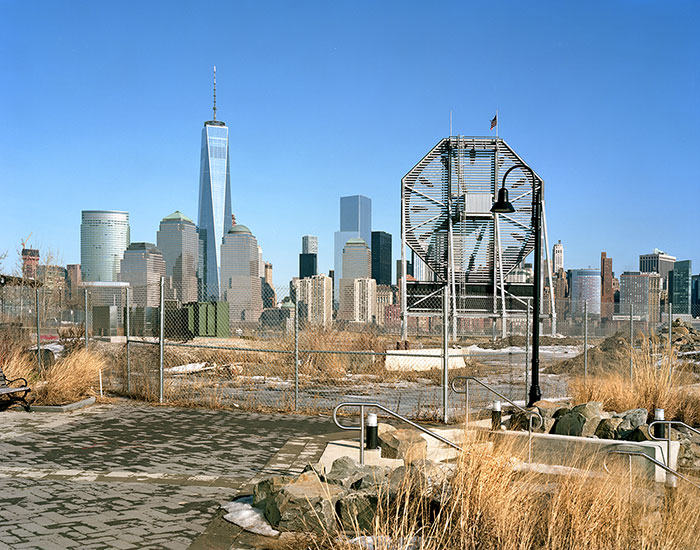
Behind the Colgate clock, Jersey City, New Jersey (4×5 film) — © Brian Rose
As some of you know, I’ve been working on a book about the World Trade Center for some time. Just before the 10th anniversary of 9/11, I came to the realization that I had in my archive a remarkable series of pictures — made at different times in different formats — that focused on the Twin Towers as a presence ( and absence) on the New York skyline. It was too late to produce a book in conjunction with the anniversary, but I began putting together a dummy based on what I had. And at the same time I continued to make photographs that showed the emergence of the new Trade Center, specifically One WTC, now completed, which stands as tall as the former Twin Towers.
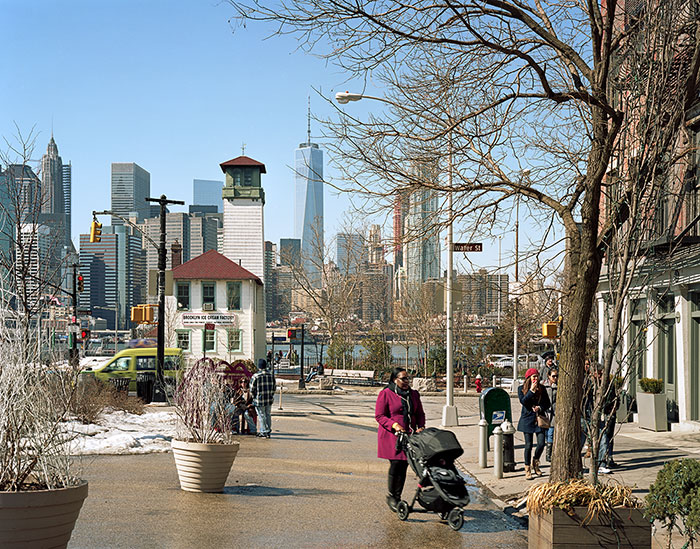
Old Fulton Street, Brooklyn (4×5 film) — © Brian Rose
None of my Twin Towers photographs were ever primarily about the buildings themselves, but rather they were urban landscapes that included the towers as architectural signposts. As the new tower of One WTC rose to fill the hole in the sky left by the destruction of 9/11, I chose to treat it the same way, as part of something, as opposed to an object all by itself. Nevertheless, I did not feel that I had one singular image (or a few) that adequately described the new tower as a prominent architectural expression.
So, when the weather broke earlier in the week, soaring into the 50s, I dashed out with my 4×5 view camera and spent a day stalking One WTC from various vantage points in Manhattan, Brooklyn, and Jersey City. Three days later, I’m still a bit sore from the exertion, but it was a great day, and I’m pleased with what I came up with.
There remain many unanswered questions about One WTC. Does it command the skyline as powerfully as the Twin Towers did? Does the design make the kind of iconic statement that many wanted from it? What does it mean to people across the political spectrum — some still insist on calling it “Freedom Tower.” And was it necessary to build it at all? My book will not settle any controversies about the new building, but ending the narrative with several strong images of the tower seemed a necessity in bringing the story around full circle.
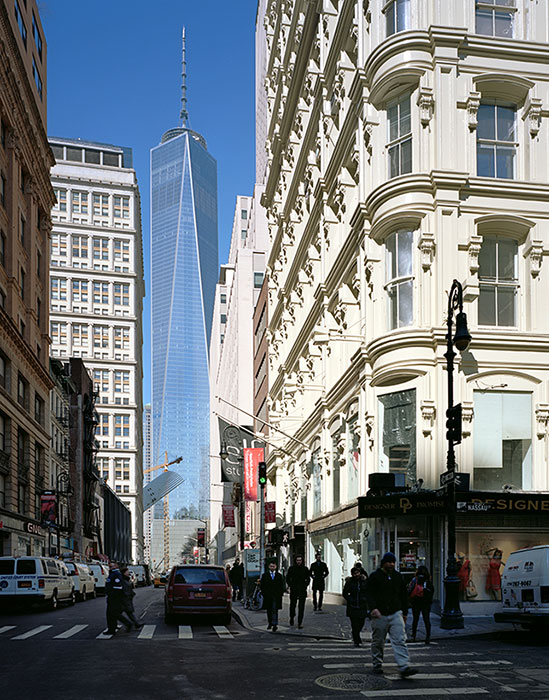
Fulton Street (4×5 film) — © Brian Rose
There was a time during the 20th century when the skyline of lower Manhattan had an almost romantic storybook aspect. It was defined by a number of thin towers with spires like the neo-gothic Woolworth Building from 1913 and later, the Art Deco styled Cities Service Building. The first significant disruption to the stalagmite look of lower Manhattan was the Chase Manhattan Bank building, a modernist slab uncomfortably inserted among its svelte neighbors. The building itself, arguably, is one of the best early modernist office towers in Manhattan, but it began a trend of ever bulkier boxes that eventually obscured many of Manhattan’s most iconic skyscrapers.
Nevertheless, when the Twin Towers went up in 1974 they dominated the skyline in almost every direction. When I did my pictures of lower Manhattan in the early 80s they were ubiquitous, poking up and between other buildings, visible from a million different vantage points. It helped, of course, that there were two of them, and the vertical pin striping of the skin — the vulnerable exo-skeletons of the towers — seemed always to lead the eye upward.
One World Trade Center, despite its height, seems lost in the crowd much of the time. And while the Twin Towers often visually lined up with the erratic street grid of downtown Manhattan, the new tower seems rarely to do so. One exception, is Fulton Street where I photographed it juxtaposed with a richly articulated cast iron building from more than a hundred years ago. And as before with the Twin Towers, One WTC appears at its most commanding from across the Hudson in New Jersey.
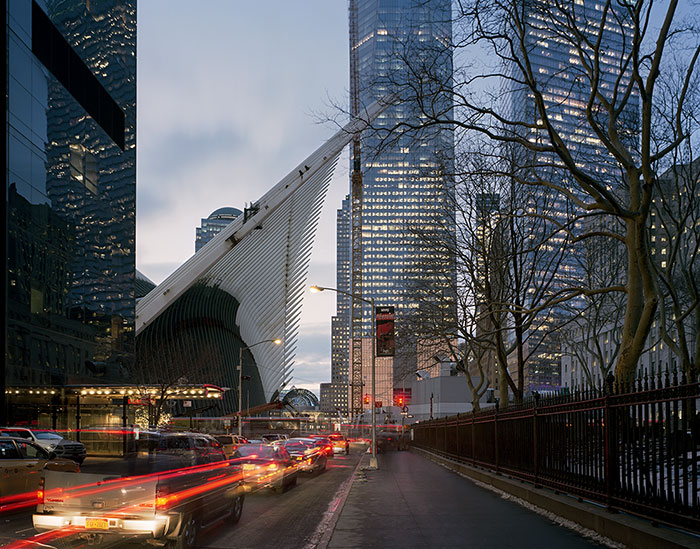
Fulton Street (4×5 film) — © Brian Rose
The rebuilding of the World Trade Center is ongoing, and construction will dominate the area for years. But several WTC towers have been completed, and Santiago Calatrava’s winged transportation center is getting closer to taking flight. The memorial fountains and the 9/11 Museum, most of which is underground, will not be a part of my narrative, which is focused on the skyline of New York, its mythic nature, and its more workaday reality as seen from the ground — on the street — the democratic commons of New York.
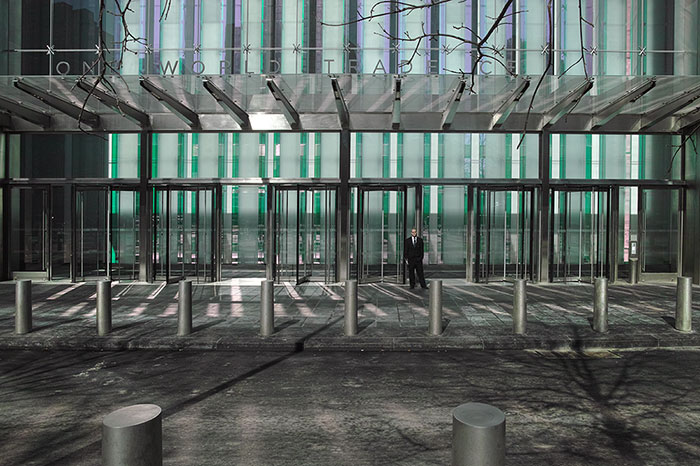
One WTC entrance — © Brian Rose
There is no doubt, however, in the post-9/11 political climate, that the democratic commons is under assault. The Trade Center site crawls with police officers and other agents of what is now painfully called Homeland Security. And various private security guards hover about at the ready to correct the wayward tourist or local who finds him or herself caught in the blurring confusion between public and private property. These zones of ambiguity are multiplying around the city, not just at the World Trade Center.
The photograph above shows the entrance to One World Trade Center, a strangely beautiful, but chilling place — the glinting sunlight reflected onto the street, the regimented rows of steel bollards, the striping of the colored glass behind the revolving doors, the solitary black-suited sentinel awaiting anyone brave enough to step forward with the idea of entering this silent fortress.